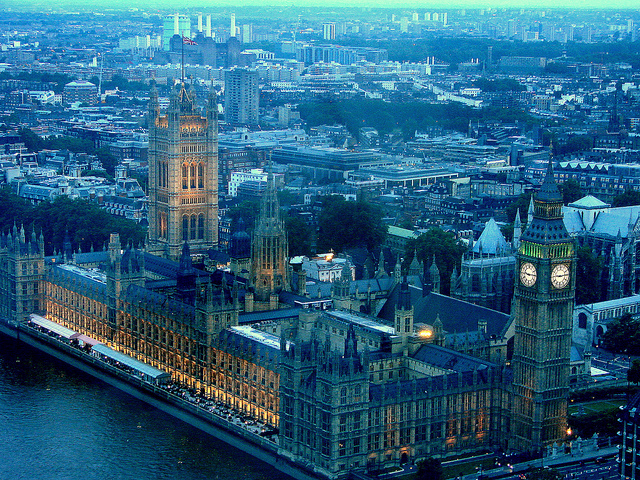The Constitutional Standards of the House of Lords’ Constitution Committee: A valuable tool for enhancing scrutiny
To mark the launch of the second edition of The Constitutional Standards of the House of Lords Constitution Committee, Jack Simson Caird considers the role that a set of constitutional standards could play in the current government. Drawing on the example of English votes for English laws, he argues that such a code would increase the quality of scrutiny of proposed changes to parliamentary procedure.
This week, the Constitution Unit, with the support of the Constitution Society, is publishing the second edition of The Constitutional Standards of the House of Lords Constitution Committee. The report, by Robert Hazell, Dawn Oliver and myself, contains a code of 140 constitutional standards, covering five areas: the rule of law, delegated powers, the separation of powers, individual rights and parliamentary procedure. The second edition extracts and codifies standards from all 168 reports of the House of Lords’ Constitution Committee published from its inception in 2001 to the end of the 2010-2015 Parliament.
When the first edition of the code was published in January 2014, I made the basic case for the use of a code of constitutional standards within Parliament. In this post, I focus on the role that a code of constitutional standards could play in the specific circumstances facing Parliament today: that of the first parliamentary session of a newly elected government intent on making major constitutional changes. In particular, I will examine the introduction of English votes for English laws (EVEL) as an example of constitutional change, and explore how the use of this code in both Houses of Parliament and in government could enhance the scrutiny of those proposed changes to parliamentary procedure.
A defining feature of the UK’s constitution is that a government fresh from the polls can use its majority in the House of Commons to implement major constitutional change in their first parliamentary session. If the policy was in the manifesto of the winning party then the Salisbury Convention means that it will not be blocked in the second chamber. The introduction of changes at this stage means they will be able to ‘bed down’ during the whole of the Parliament. In one sense this is a strength of the UK constitution. A weakness of this arrangement is that it can result in changes being made to the constitution without the detailed analysis and scrutiny within Parliament that they deserve. This is where a code of parliamentary constitutional standards, such as the one included in this report, could make a difference.
The use of such standards in the course of the legislative process would not change the democratic credentials of the UK’s system of constitutional change, but could potentially increase the quality and depth of the scrutiny applied to a proposed change to the constitution both during the parliamentary process and ‘upstream’ in government while policies to implement change are being developed formulated. Any such code of standards would not be legally binding, but instead would be used by parliamentarians, parliamentary committees and by government to frame their analysis of a change to the constitution.
The current government’s proposed introduction of EVEL through a change to the standing orders of the House of Commons is an important, albeit unusual, example of the current process of constitutional change in the UK. Despite the fact that EVEL was set out in detail in the Conservative manifesto, the substance of the proposals, and the process for their implementation used by the government have both attracted strong criticisms. To illustrate the value of a code of constitutional standards for parliamentary scrutiny, the remainder of this post will highlight a number of standards within the updated code that could be used by both government and parliamentarians to justify and critique this particular reform.
More than any other issue, the House of Lords Constitution Committee’s reports have criticised successive governments’ approaches to constitutional change. As a result a number of the standards in the code provide important guidance as to how constitutional change should be conducted, in order to reflect its significance to our democracy and the parliamentary executive on which it rests. The Constitution Committee has consistently argued that significant constitutional change should be subject, at a minimum, to the ordinary primary law-making process. Standard 2.3.10 states ‘secondary legislation is not the appropriate way to proceed with significant constitutional change.’ Standing orders can be distinguished from secondary legislation, but the basic point is that major constitutional changes should at least be accorded the same level of deliberation as other major changes to public policy. This can be seen in standard 5.3.8, which states that constitutional legislation should not be fast-tracked through Parliament, and standard 5.3.6, which states that ‘significant constitutional change should be preceded by significant public engagement and consultation.’ Even if one accepts that EVEL should take the form of a change to the standing orders of the House of Commons, that is no reason why the standards of scrutiny and deliberation before such a change is made should not match those that would be expected of significant primary legislation.
A good number of the standards in the code concern the level of justification provided by the government to Parliament for the substance of a change to the constitution. Standard 5.3.1 states that the minister responsible should, when a Bill is introduced, explain in writing ‘the impact of the proposals upon the existing constitutional arrangements’. Chris Grayling, the Leader of the House of Commons, has emphasised that the government’s plans are a direct response to the West Lothian question and will strengthen the Union by providing a distinct voice for the English nation within our constitution. But beyond this, the government has argued that the constitutional impact of the change to the standing orders of the Commons is limited. The very fact that the standing orders have been chosen rather than legislation is presented as evidence of the self-contained nature of the reforms. Despite this, concerns have been raised within Parliament over the reforms’ potential to have a broader constitutional impact than appears to be envisaged by the government. The scrutiny of such potential changes would be greatly enhanced if the government responded to standard 5.3.1 by providing its own analysis of how, for example, the changes might impact on the constitution beyond answering the West Lothian question.
In terms of the substances of the EVEL proposals, standard 3.3.2 states that ‘laws should not add unnecessary complexity to the law-making process’. This standard, which was extracted from the Constitution Committee’s report on the Government of Wales Act 2006, is an important reminder that even relatively small changes to the legislative process may have unforeseen consequences, particularly for legislative scrutiny. While the government has argued that the EVEL changes they propose do not represent a major departure from existing parliamentary procedures, the introduction of both a veto for English MPs, and the use of a double-majority system for votes on Lords amendments that affect only England, or England and Wales, have the potential to make the legislative process more complex. The role of the Speaker in certifying whether Bills or specific provisions should be subject to the new procedure is a good example of such potential complexity. A major characteristic of the Westminster legislative process has been the absence of veto players and double or special majority requirements: departing from this approach deserves specific justification.
If a parliamentary committee were to develop and apply a set of constitutional standards, or to adopt the standards in our Report, this could improve how the quality of scrutiny and debate on constitutional change. These standards serve as a basic benchmark through which proposals can be evaluated, but perhaps most importantly they could serve as guidance for governments to improve their approach to constitutional change. If a government used such standards to frame the justifications for their proposals, then parliamentarians would be better placed to give constitutional changes the scrutiny they deserve.
The example of EVEL indicates that the application and development of constitution standards might also be beneficial for the House of Commons – which after all is the Chamber most strongly affected by them. In a debate in the Lords on the government’s proposals on 21 July, numerous peers called for a report from the Constitution Committee. In response, Lord King of Bridgewater noted ‘the long-established practice of the Constitution Committee of this House not to interfere with the procedural arrangements of the House of Commons’ and stated that ‘it has regarded that as being outside its remit’. This provides an interesting contrast with the passage of the Fixed-term Parliament Act 2011, which also concerned the procedural arrangements of the House of Commons. In this instance, changes were made via primary legislation and were therefore subject to scrutiny in the Lords, including from the Constitution Committee. As a consequence, major amendments were made to change the role of Speaker of the House of Commons in the vote of confidence procedure under the 2011 Act. These amendments were agreed in the Lords as a result of objections raised by peers.
The Constitution Committee has for the past 14 years developed a set of distinctively parliamentary constitutional standards for how constitutional change should be conducted. This second edition of our Report offers a concise, accessible and up-to-date guide to their work. All parliamentarians should, in our view, make the most of the Constitution Committee’s important work by demanding that constitutional change meets the high standard of debate and scrutiny that it deserves.
—
The Constitutional Standards of the House of Lords Constitution Committee: Second Edition is available to read and download here. This post represents the views of the author and not those of Democratic Audit. Please read our comments policy before posting. It originally appeared on the Constitution Unit blog.
—
 Dr. Jack Simson Caird is Lecturer in Law at the University of Sussex.
Dr. Jack Simson Caird is Lecturer in Law at the University of Sussex.






 Democratic Audit's core funding is provided by the Joseph Rowntree Charitable Trust. Additional funding is provided by the London School of Economics.
Democratic Audit's core funding is provided by the Joseph Rowntree Charitable Trust. Additional funding is provided by the London School of Economics.
[…] The problem is that you probably never heard of most of them. That’s why we made a list of 50 of the most useful websites on the internet! Midomi.com Basically Shazam for PC. Can you join us on 8 September? The Constitutional Standards of the House of Lords’ Constitution Committee: A valuable tool for en…. […]
RT @democraticaudit: The Constitutional Standards of the House of Lords’ Constitution Committee: A valuable tool for enhancing scrutiny htt…
[…] The Constitutional Standards of the House of Lords’ Constitution Committee: A valuable tool for en…. To mark the launch of the second edition of The Constitutional Standards of the House of Lords Constitution Committee, Jack Simson Caird considers the role that a set of constitutional standards could play in the current government. […]
Constitutional standards used by the House of Lords’ Constitution Committee: A valuable tool for enhancing scrutiny? https://t.co/h3nyVNN4KS
The Constitutional Standards of the House of Lords’ Constitution Committee: A valuable tool for enhancing scru… https://t.co/tqgD0CycYS
The Constitutional Standards of the House of Lords’ Constitution Committee: A valuable tool for enhancing scrutiny https://t.co/vMXiGBv2nO…
The Constitutional Standards of the House of Lords’ Constitution Committee: A valuable tool… https://t.co/67fBvQNVBN https://t.co/LXkVmD7wjw